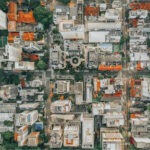Racial residential segregation is “the physical separation of the races in residential contexts” (Williams & Collins, 2001, p. 405). Explicit government policies through the first half of the 20th century were designed to keep Black and white residents separate (Rothstein, 2017). Across the United States, patterns of Black-white residential segregation have remained etched in place for the past 80 years (Williams et al., 2019). Today, we see an inequitable distribution of risks (e.g., toxic waste, community stress, unhealthy food) and resources (e.g., parks, community resources, healthy food) across neighborhoods based on the racial makeup of residents, which drives health inequities.
Neighborhoods across the United States are highly segregated by race.
While residential segregation exists between multiple racial/ethnic groups, Black-white segregation is the most enduring, pronounced, and distinctive form of racial/ethnic segregation in the United States (Vock et al., 2019; Williams & Collins, 2001; Williams et al., 2019).
Racist government policies through the first half of the 20th century created racial residential segregation and prevented Black families and other families of color from owning homes.
Explicit governmental policies and programs implemented in the 1930s were designed to keep racial groups separate in residential areas. As a part of the New Deal legislation, The Federal Housing Administration provided low-cost loans for working-class white families to move out of public housing and into all-white suburban neighborhoods while simultaneously denying Black families the same opportunities (Rothstein, 2017). Once white families moved out of public housing, Black families moved into the newly vacant units. Jobs and services left the areas surrounding the public housing units. The jobs moved into the suburbs, creating a lack of opportunities, high unemployment rates, and concentrated poverty in the now predominantly-Black neighborhoods.
At the same time, redlining ensured that Black families could not secure loans to purchase or improve homes in their communities. Throughout the 1940s and 1950s, the Home Owners’ Loan Corporation (HOLC) created “Residential Security” maps to guide lenders, appraisers, and real estate agents in evaluating investment risk. Based on the false claim that property values decreased with the presence of Black residents, HOLC codified investment risk based on the racial composition of neighborhoods. As the proportion of Black residents increased, so too did the purported level of risk, ranging from green = “best” to indicate mostly white neighborhoods, blue = “still desirable,” yellow = “definitely declining,” red = “hazardous” for predominantly Black and immigrant neighborhoods (hence the name, “redlining”). Consequently, many Black families could not secure the funds to purchase or repair homes in their communities, which became targets of continued disinvestment. There are many helpful resources for those interested in learning more about these policies:
- Housing Segregation Timeline, Legal Services of Central New York
- Interview with Richard Rothstein, author of The Color of Law, NPR
- Interview with Richard Rothstein, author of The Color of Law, Smithsonian
- Massey DS, Denton NA. American apartheid: Segregation and the making of the underclass. Harvard University Press; 1993.
- Segregation in the United States, History channel
- The Color of Law: A Forgotten History of How Our Government Segregated America, by Richard Rothstein
The legacy of racist housing policies drives health inequities to this day
Despite the outlawing of explicit, legally codified racial residential segregation in 1968, the consequences of historical redlining continue for racial inequality in health, wealth, and well-being (Rothstein, 2017).
Those in positions of power have continued to disinvest in communities of color, leading to a higher concentration of environmental and social risk factors, including:
- Toxic air and polluted water – toxic-waste producing facilities and other health-harming environmental hazards are disproportionately placed in low-income Black and Brown neighborhoods (Woo et al., 2018; Morello-Frosch & Lopez, 2006)
- Road noise and traffic density (Casey et al., 2017),
- Tobacco and liquor stores (Bower et al., 2014; Scott et at., 2020; Moore & Diez-Roux, 2006)
- Police presence and other chronic stressors (Siegel et al., 2019; Kent & Carmichael, 2013).
At the same time, decision-makers and businesses deprive these communities of crucial health-promoting resources and opportunities, such as:
- Quality education and employment opportunities (Denton, 1995; Frankenberg, 2013; Jargowsky, 2014; Institute for Research on Poverty, 2018; Turner, Cheshire et al., 2003; Dickerson 2008; Turner, 2008),
- Healthy and affordable food options (Bower et al., 2014; Moore & Diez-Roux, 2006),
- Greenspace, parks, and other recreational amenities (Nardone et al., 2021).
This inequitable distribution of risks and resources has caused strong associations between racial residential segregation and racial inequities across multiple health outcomes.
For example, researchers at UC Berkeley have shown how historically redlined areas have higher rates of adverse birth outcomes (A. L. Nardone et al., 2020) and emergency department visits for asthma (A. Nardone, J. A. Casey et al., 2020) in California. These and other studies (Beyer et al., 2016; Huggins, 2017; Krieger, Van Wye, et al., 2020; Krieger et al., 2020; McClure et al., 2019) demonstrate the lasting impacts of historical redlining on present-day health inequities including cancer, adverse birth outcomes, and poor self-rated health.
Additionally, discriminatory land-use zoning practices have created and maintained racial housing disparities (e.g., limiting dwelling construction to single-family or low-density housing rather than lower-rent multi-unit buildings) in predominantly white and wealthier neighborhoods; concentrating the zoning for undesirable uses (e.g., industrial) to communities of color and lower-income neighborhoods which can further erode property values and prevent wealth building (Swope & Hernández, 2019).
These health effects are caused by systemic disinvestment in communities of color, not by anything about the communities themselves (Keene & Padilla, 2014).
Racist housing policies excluded Black families from wealth-building opportunities.
Homeownership is a primary means of wealth accumulation in the United States. The government’s systematic exclusion of Black families from obtaining loans to purchase homes in white suburban communities (via racially-restrictive covenants) or their communities (via redlining) means many Black families have been deprived of a crucial mechanism for building intergenerational wealth (Rothstein, 2017; Williams & Collins, 2001). The entrenchment of racial segregation meant there were fewer investments in Black neighborhoods and a smaller tax base for schools which fostered poverty conditions perpetuated by Black Americans earning roughly 60 cents to the dollar that white Americans make, with only 10 cents to the dollar that white Americans have in wealth (Rothstein, 2017; Williams & Collins, 2001).
- Bailey, Z. D., Krieger, N., Agénor, M., Graves, J., Linos, N., & Bassett, M. T. (2017). Structural racism and health inequities in the USA: Evidence and interventions. The Lancet, 389(10077), 1453–1463. https://doi.org/10.1016/S0140-6736(17)30569-X
- Beyer, K. M., Zhou, Y., Matthews, K., Bemanian, A., Laud, P. W., & Nattinger, A. B. (2016, Jul). New spatially continuous indices of redlining and racial bias in mortgage lending: links to survival after breast cancer diagnosis and implications for health disparities research. Health Place, 40, 34-43. https://doi.org/10.1016/j.healthplace.2016.04.014
- Culhane, J. F., & Elo, I. T. (2005). Neighborhood context and reproductive health. American Journal of Obstetrics and Gynecology, 192(5), S22–S29. https://doi.org/10.1016/j.ajog.2005.01.071
- Culhane, J. F., & Goldenberg, R. L. (2011). Racial Disparities in Preterm Birth. Seminars in Perinatology, 35(4), 234–239. https://doi.org/10.1053/j.semperi.2011.02.020
- Giurgescu, C., Zenk, S. N., Dancy, B. L., Park, C. G., Dieber, W., & Block, R. (2012). Relationships among Neighborhood Environment, Racial Discrimination, Psychological Distress, and Preterm Birth in African American Women. Journal of Obstetric, Gynecologic, & Neonatal Nursing, 41(6), E51–E61. https://doi.org/10.1111/j.1552-6909.2012.01409.x
- Haas JS, Earle CC, Orav JE, et al. Racial segregation and disparities in breast cancer care and mortality. 2008;113(8):2166-2172.
- Huggins, J. C. (2017). A cartographic perspective on the correlation between redlining and public health in Austin, Texas–1951. Cityscape, 19(2), 267-280.
- Kershaw KN, Diez Roux AV, Burgard SA, Lisabeth LD, Mujahid MS, Schulz AJ. Metropolitan-level racial residential segregation and black-white disparities in hypertension. American journal of epidemiology. 2011;174(5):537-545.
- Kramer MR, Hogue CR. Is segregation bad for your health? Epidemiologic reviews. 2009;31(1):178-194.
- Krieger N, Feldman JM, Kim R, Waterman PD. Cancer incidence and multilevel residential economic and racial segregation measures for cancer registries. JNCI Cancer Spectrum. 2018;2(1):pky009.
- Krieger N, Singh N, Waterman PD. Metrics for monitoring cancer inequities: residential segregation, the Index of Concentration at the Extremes (ICE), and breast cancer estrogen receptor status (USA, 1992–2012). Cancer Causes & Control. 2016;27(9):1139-1151.
- Krieger, N., Chen, J. T., Waterman, P. D., Rehkopf, D. H., & Subramanian, S. V. (2005). Painting a more accurate picture of US socioeconomic and racial/ethnic health inequalities: The Public Health Disparities Geocoding Project. American Journal of Public Health, 95(2), 312–323.
- Krieger, N., Van Wye, G., Huynh, M., Waterman, P. D., Maduro, G., Li, W., Gwynn, R. C., Barbot, O., & Bassett, M. T. (2020). Structural Racism, Historical Redlining, and Risk of Preterm Birth in New York City, 2013–2017. American Journal of Public Health(0), e1-e8.
- Krieger, N., Wright, E., Chen, J. T., Waterman, P. D., Huntley, E. R., & Arcaya, M. (2020). Cancer Stage at Diagnosis, Historical Redlining, and Current Neighborhood Characteristics: Breast, Cervical, Lung, and Colorectal Cancer, Massachusetts, 2001-2015. American Journal of Epidemiology.
- Logan TD, Parman JM. Segregation and mortality over time and space. Social Science & Medicine. 2017;30:1e10.
- McClure, E., Feinstein, L., Cordoba, E., Douglas, C., Emch, M., Robinson, W., Galea, S., & Aiello, A. E. (2019). The legacy of redlining in the effect of foreclosures on Detroit residents’ self-rated health. Health & Place, 55, 9-19.
- Mujahid, M. S., Sohn, E. K., Izenberg, J., Gao, X., Tulier, M. E., Lee, M. M., & Yen, I. H. (2019). Gentrification and Displacement in the San Francisco Bay Area: A Comparison of Measurement Approaches. International Journal of Environmental Research and Public Health, 16(12), 2246. https://doi.org/10.3390/ijerph16122246
- Nardone, A. L., Casey, J. A., Rudolph, K. E., Karasek, D., Mujahid, M., & Morello-Frosch, R. (2020). Associations between historical redlining and birth outcomes from 2006 through 2015 in California. PLoS ONE, 15(8), e0237241.
- Nardone, A., Casey, J. A., Morello-Frosch, R., Mujahid, M., Balmes, J. R., & Thakur, N. (2020). Associations between historical residential redlining and current age-adjusted rates of emergency department visits due to asthma across eight cities in California: an ecological study. The Lancet Planetary Health, 4(1), e24-e31.
- Nardone, A., Chiang, J., & Corburn, J. (2020). Historic Redlining and Urban Health Today in US Cities. Environmental Justice.
- Riley AR. Neighborhood Disadvantage, Residential Segregation, and Beyond—Lessons for Studying Structural Racism and Health. Journal of Racial and Ethnic Health Disparities. 2018;5(2):357-365.
- Rothstein, R. (2017). The Color of Law: A forgotten history of how our government segregated America. Liveright Publishing Corporation.
- Schnake-Mahl, A. S., Jahn, J. L., Subramanian, S. V., Waters, M. C., & Arcaya, M. (2020). Gentrification, Neighborhood Change, and Population Health: A Systematic Review. Journal of Urban Health, 97(1), 1–25. https://doi.org/10.1007/s11524-019-00400-1
- Sharkey, P. (2013). Stuck in Place: Urban Neighborhoods and the End of Progress toward Racial Equality. The University of Chicago Press.
- Tehrani, S. O., Wu, S. J., & Roberts, J. D. (2019). The Color of Health: Residential Segregation, Light Rail Transit Developments, and Gentrification in the United States. International Journal of Environmental Research and Public Health, 16(19), 3683. https://doi.org/10.3390/ijerph16193683
- Tulier, M. E., Reid, C., Mujahid, M. S., & Allen, A. M. (2019). “Clear action requires clear thinking”: A systematic review of gentrification and health research in the United States. Health & Place, 59, 102173. https://doi.org/10.1016/j.healthplace.2019.102173
- Vock, D. C., Charles, B., & Macaig, M. (2019). Residential Segregation Data for U.S. Metro Areas. Governing. Retrieved 08/28/20 from https://www.governing.com/gov-data/education-data/residential-racial-segregation-metro-areas.html
- Williams, D. R., & Collins, C. (2001). Racial residential segregation: A fundamental cause of racial health disparities. Public Health Reports, 116(5), 404–416.
- Williams, D. R., Lawrence, J. A., & Davis, B. A. (2019). Racism and health: evidence and needed research. Annual Review of Public Health, 40, 105-125.
- Zhou Y, Bemanian A, Beyer KM. Housing discrimination, residential racial segregation, and colorectal cancer survival in southeastern Wisconsin. In: AACR; 2017.
- Zuk, M., & Chapple, K. (2015). Redlining and Gentrification. Urban Displacement Project. https://www.urbandisplacement.org/redlining
- Arcaya, M. C. (2018). Neighborhood Foreclosures and Health. In D. T. Duncan & I. Kawachi (Eds.), Neighborhoods and Health (Second, pp. 293–319). Oxford University Press.
- Keene, D. E., & Geronimus, A. T. (2011). “Weathering” HOPE VI: The Importance of Evaluating the Population Health Impact of Public Housing Demolition and Displacement. Journal of Urban Health, 88(3), 417–435. https://doi.org/10.1007/s11524-011-9582-5
- Swope, C. B., & Hernández, D. (2019). Housing as a determinant of health equity: A conceptual model. Social Science & Medicine, 243, 112571. https://doi.org/10.1016/j.socscimed.2019.112571
- Woo, B., Kravitz-Wirtz, N., Sass, V., Crowder, K., Teixeira, S., & Takeuchi, D. T. (2019). Residential segregation and racial/ethnic disparities in ambient air pollution. Race and social problems, 11(1), 60-67.
- Morello-Frosch, R., & Lopez, R. (2006). The risk score and the color line examine segregation’s role in environmental health disparities. Environmental Research, 102(2), 181-196.
- Casey, Joan A., Rachel Morello-Frosch, Daniel J. Mennitt, Kurt Fristrup, Elizabeth L. Ogburn, and Peter James. “Race/ethnicity, socioeconomic status, residential segregation, and spatial variation in noise exposure in the contiguous United States.” Environmental health perspectives 125, no. 7 (2017): 077017.
- Bower, K. M., Thorpe Jr, R. J., Rohde, C., & Gaskin, D. J. (2014). The intersection of neighborhood racial segregation, poverty, and urbanicity and its impact on food store availability in the United States. Preventive medicine, 58, 33-39.
- Kent, S. L., & Carmichael, J. T. (2014). Racial residential segregation and social control: A panel study of the variation in police strength across US cities, 1980–2010. American Journal of Criminal Justice, 39(2), 228-249.
- Siegel, M., Sherman, R., Li, C., & Knopov, A. (2019). The relationship between racial residential segregation and black-white disparities in fatal police shootings at the city level, 2013–2017. Journal of the National Medical Association, 111(6), 580-587.
- Scott, J., Danos, D., Collins, R., Simonsen, N., Leonardi, C., Scribner, R., & Herd, D. (2020). Structural racism in the built environment: Segregation and the overconcentration of alcohol outlets. Health & place, 64, 102385.
- Moore, L. V., & Diez Roux, A. V. (2006). Associations of neighborhood characteristics with the location and type of food stores. American journal of public health, 96(2), 325-331.
- Denton, N. A. (1995). The persistence of segregation: Links between residential segregation and school segregation. L. Rev., 80, 795.
- Frankenberg, E. (2013). The role of residential segregation in contemporary school segregation. Education and Urban Society, 45(5), 548-570.
- Paul Jargowsky, “Segregation, Neighborhoods and Schools,” in Choosing Homes, Choosing Schools, ed. Annette Lareau and Kimberly Goyette (New York: Russell Sage Foundation, 2014), 103-4.
- Institute for Research on Poverty (2018). A history of residential segregation in the United States – article summarizing the May 2018 lecture by Richard Rothstein at the University of Wisconsin-Madison, Institute for Research on Poverty
- Turner (2008), Residential Segregation and Employment Inequality chapter, in Carr, J. H., & Kutty, N. K. (Eds.). Segregation: The rising costs for America. Routledge.Margery Austin Turner
- Cheshire et al. (2003), Income inequality and residential segregation: labor market sorting and the demand for positional goods chapter, in Martin, R., & Morrison, P. S. (Eds.). (2003). Geographies of labour market inequality. Routledge.
- Dickerson, N. (2008). Occupational and residential segregation: The confluence of two systems of inequality. Labor Studies Journal, 33(4), 393-411.
- Nardone, A., Rudolph, K. E., Morello-Frosch, R., & Casey, J. A. (2021). Redlines and greenspace: the relationship between historical redlining and 2010 greenspace across the United States. Environmental health perspectives, 129(1), 017006.
- Keene, D. E., & Padilla, M. B. (2014). Spatial stigma and health inequality. Critical Public Health, 24(4), 392-404.





